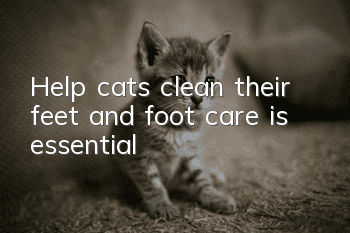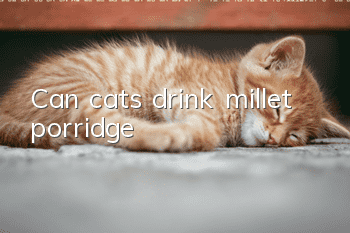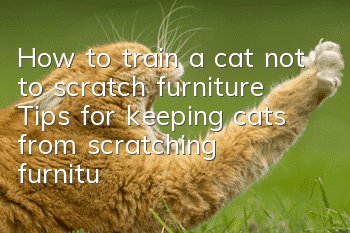Help cats clean their feet and foot care is essential

Cats are famous for their love of cleanliness, and they can clean themselves. However, they are animals after all, and they cannot clean many places. Moreover, after cats clean themselves, they like to swallow many foreign objects into their stomachs, making them prone to illness. Therefore, pet owners should often help their cats clean their bodies, especially the feet that are prone to inflammation.
1. The main reasons why cats get athlete’s foot
1. Bacterial breeding and infection
Cats can also get athlete's foot if they don't pay enough attention to cleaning their feet. The main reason why cats get athlete's foot is bacterial growth. In severe cases, it can lead to paronychia infection, making it difficult for cats to walk, so it should not be underestimated.
2. The temperature is hot and humid
For long-haired cats, the hair on their foot pads is too long and thick and cannot be trimmed in time. When the temperature is hot and humid, bacteria will breed. The cat's foot pads cannot be cleaned sufficiently because the hair is too thick, causing the cat's foot pads to become peeling or even rotten. Ya.
3. Poor environmental hygiene
If the environment is not hygienic, bacteria will breed, and if the cat steps on it, the fungus will get into the cat's nails and cause infection. This condition is common in stray cats.
4. Cats are lazy to clean
Cats are lazy, or have difficulty licking their fur, and neglect to clean their feet, resulting in insufficient cleanliness and athlete's foot.
2. Seven Steps to Cleaning Cat’s Feet
1. Mental preparation before washing
Preparation before washing: Hold the base of the cat's front paws and gently put its front paws into the basin. It is best not to choose a basin that is too large, otherwise, it will easily splash water everywhere. Most cats will struggle at this time, and owners should comfort them gently.
2. Remove dirt from the soles of your feet
Gently rub the soles of the paws first, then the rest of the toes, and do not let go between the toes. At this time, you should not rub the soles of the feet hard, just remove the grass blades or mud and other dirt attached to the soles of the feet.
3. Check the claw wounds
Foot examination. After washing the dirt from the paw, you can start to carefully inspect the entire paw. Check whether there are foreign objects stuck in the meat pads and between the toes, whether there are cuts or punctures, whether there are inflammation or hair loss on the back of the paws, etc.
4. Scrub between the pads and toes
Scrub the meat pads. We have completely removed the dirt on the surface of the cat's soles and confirmed that there are no abnormalities on the soles of the cat's paws. The owner can start to carefully scrub the cat’s meat pads and toe gaps.
5. Use bath soap to clean
Use bath liquid. Whether it is a long-haired or short-haired cat, using a cat-specific bath soap during the final cleaning process can make the fur on its paws soft and shiny. Some bath solutions need to be diluted before use. Please read the instructions carefully before use..
6. Dry paws gently
Dry your paws. After completely washing away the foam of the bath solution, dry the paws with an absorbent towel, paying attention to the back of the paws and the middle of the toes. Many kittens are afraid of putting their feet in a towel when they are not used to washing their feet, so owners should not use too much force.
7. Blow-dry the dog’s coat
Blow dry the coat. Dry the hair on your paws with a hair dryer. This is the most important thing to do every time you wash your feet. Cats' paws are prone to skin diseases if their fur is allowed to dry naturally. Choosing a hair dryer that is compact and low-noise can slightly reduce your cat’s uneasiness.
3. The consequences of not trimming the cat’s feet
1. Cats sweat and suffer from heatstroke
Cats do not have sweat glands on their bodies. Cat sweat glands grow on the cat’s foot pads. Regularly trimming the cat’s foot hair can help the cat dissipate heat and sweat and prevent cats from heatstroke.
2. Be careful of nail inflammation
If the cat is lazy or fat, it is inconvenient to lick its fur. If parents cannot trim their foot hair regularly, the long foot hair can easily breed bacteria, causing inflammation of the cat's toes and nails. In severe cases, it may develop into onychomycosis or onychomycosis. Paronychia.
3. It’s easy to eat insect eggs
The hair on a cat's feet can easily be stained with bacteria or parasite eggs when the cat is walking (if there are cockroaches in the house, it can easily be stained with parasite eggs). Cats will lick the bacteria and parasite eggs into their stomachs when cleaning their paws. There is some damage to the health of cats.
4. Apply ointment when sick
Some pet owners are very anxious when they find that their cat lovers have stinky feet. In fact, it is not necessary. This situation is still easy to treat. As long as you apply erythromycin ointment on the cleaned cat's feet, it will heal quickly.
- Why does the cat vomit after eating it?
- How often should cats take deworming medicine?
- Cat’s belly is sagging like a water bag
- Cat food selection and matching methods
- What to do if the kitten is too thin? Provide proper nutritional management
- What can kittens eat to gain weight quickly?
- What is nasal obstruction? Does a cat need to be quarantined for life if it has nasal obstruction?
- How to stop a cat from meowing in the cage
- What's going on if the cat doesn't eat or drink?
- What is better for Bombay cats to eat?



